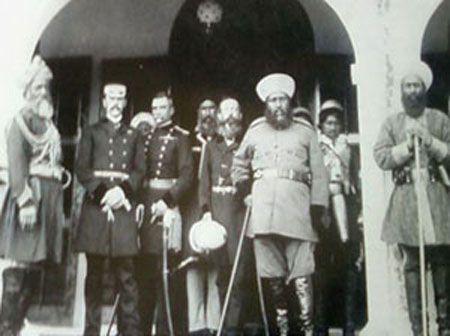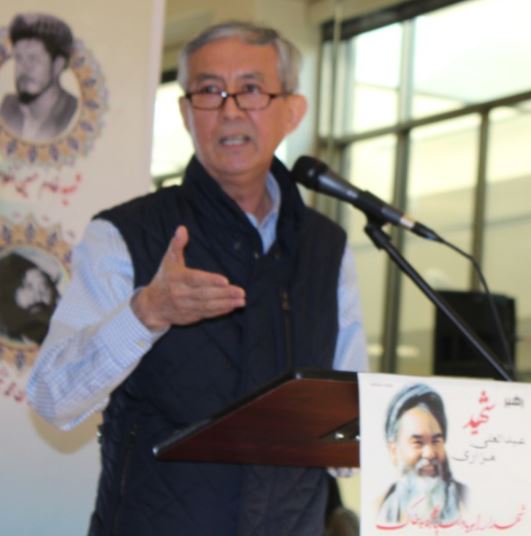The Hazara nation, now living mostly in Central Afghanistan region known as Hazarajat, faced the worst genocide at the hands of Amir of Kabul, Abdul Rehman Khan (1880-1901) in the late 19th century. Hundreds of thousands of Hazaras were massacred, sold out as slaves to neighboring countries, and forced to migrate to Central Asia, Iran, and the Indian Subcontinent after losing their lands, but unfortunately, despite all these horrors, their names could never be mentioned on the list of international genocides. Before discussing the topic further, it would be appropriate to look at how the United Nations defines the term ‘Genocide.’
On December 9, 1948, the United Nations declared genocide a serious international crime and vowed to take disciplinary action against the perpetrators. In the Convention, genocide means any of the following acts committed with intent to destroy, in whole or in part, a nation, ethnical, racial or religious group, as such:
- Killing members of the group
- Causing serious bodily or mental harm to members of the group
- Deliberately inflicting on the group conditions of life calculated to bring about its physical destruction in whole or in part
- Imposing measures intended to prevent births within the group
- Forcibly transferring children of the group to another group
Considering this definition, so far three dozen incidents of genocide have been mentioned in various lists; some of them which took place during the 19th and 20th centuries are given below:
|
Title |
Year | Estimated No. of Deaths |
| Aboriginal Genocide in Black War Tasmania | 1825-1832 | 1 hundred to 1 thousand
|
| “Circa” genocide by Russian forces | 1864-1867 | 4 million to 15 million |
| Armenian Genocide at the hands of Ottoman armies. | 1915-1922 | 7 million to 18 million
|
| Polish Genocide at the hands of German Nazi forces | 1939-1945 | 1.8 million to 2.3 million |
| Jewish Genocide (Holocaust) at the hands of German Nazi forces | 1941-1945 | 6 million |
| Cambodian Genocide at the hands of Khmer Rouge forces | 1975-1979 | 1.4 million to 3 million |
| Rwandan genocide at the hands of Hutu forces | 1994 | 0.5 million to 0.8 million |
Source: Wikipedia https://en.wikipedia.org/wiki/Genocide (accessed April 20, 2022)
As we can see, the list mentioned above even includes incidents in which a few hundred people were killed, such as four hundred to one thousand Aborigines were killed during the ‘Black War Tasmania,’ but since it is considered genocide as per the UN definition, it has been added to the list of recognized genocides. However, it is a pity that no credible list of genocides mentions the horrific ‘Hazara genocide’ that took place in Afghanistan during the reign of Amir of Kabul, Abdul Rehman (1892-1901). Undeniable evidence of this genocide can be found in the decrees of Amir Abdul Rehman and his son Amir Habibullah, mentioned in the book Siraj-al Tawarikh, by Faiz Muhammad Katib, the official historian of the court of Kabul, and in the books and photos of European historians and writers of the time; as well as, in the official documents of the British Empire. It will suffice to mention only a few references in this regard:
- First, in August 1892, Amir Abdul Rahman Khan, through his Sunni mullahs, declared the Shia Hazaras to be infidels. The declaration allowed Hazaras’ lives and properties to be confiscated and their women and children to be enslaved by Sunnis. (Timurkhanov, Page 141-142; Diaries of Kandahar, No. 32)
- Sunni jihadis from all over Afghanistan, especially Afghan (Pashtun) Kochis, on the direction of Sunni mullahs reached Hazarajat in September 1892 with Amir of Kabul’s army to take part in a ‘holy war’ against Hazaras. According to Timurkhanov and British sources, a total of 50,000 regular Afghan troops, along with 120,000 Sunni jihadists, had gathered against the ‘infidel’ Hazaras. (Timurkhanov, p. 142)
- It was obvious that unarmed Hazara people were unable to withstand such a large army and were, therefore, defeated. Large-scale massacres took place, and minarets were formed with the heads of the Hazara victims (Daulatabadi, p. 85). According to Faiz Mohammad Katib, the official historian of the court of Kabul, “two or three Hazara women were gifted to each member of victorious army who were later sold as slaves” (Daulatabadi, p. 66, quoting Siraj al-Tawarikh). In addition to being sold as slaves, many Hazara women were raped by the Afghan army of the Amir of Kabul. In this regard, the late Daulatabadi, quoting Faiz Muhammad Katib, writes: “Though Hazara people had already accepted defeat in front of Amir of Kabul without any major resistance, their army, under the guise of collecting weapons and taxes, continued so many atrocities that the sighs and cries of the oppressed crossed the ninth heaven. A large number of people were killed, a large number of women, girls and even boys were raped. This nation (Hazaras) was so much abused that the pen is unable to express it.” (Daulatabadi, p. 58)
- Western writers also support the notion that Hazara women were enslaved. British doctor, John Alfred Gray, a personal physician to Amir Abdul Rehman Khan, narrates his experiences as follows: “Recently in Kabul it was very common sight to see a gang of Hazara women with their unveiled faces and their dingy dresses ragged and dirty conducted through the town by a small guard of soldiers with bayonets fixed. As the war progressed, they became so plentiful that His Highness would often reward a faithful servant or officer by presenting him with one or more as an addition to his Harem” (John Alfred Gray, p. 213). Later, this ugly act was turned into a regular business and taxes were levied on it. In this regard, Dr. Hassan Kakar is of the opinion that “the government got Rs 70,000 tax from the trade of Hazara slaves in Kandahar alone” (Hassan Kakar, p. 9). It must not be forgotten that at that time, the government of Amir collected only 10% tax on the trade of Hazara slaves. In this regard, the Daulatabadi further quotes Faiz Mohammad Katib as saying: “In the late 1895, Qazi Khwaja Mohammad Khan sent Rs. 1,941.5 to Amir of Kabul only for the tax collected from the trade of Hazara slaves and maids in Uruzgan. This amount was received at the rate of Rs. 15 and Rs. 20 per slave.” (Daulatabadi, p. 114)
- A large number of Hazara male captives were sent to Kabul. According to Western newspapers, the Amir of Kabul sold 10,000 Hazara prisoners as slaves in October 1893 to cover his war expenses, while the rest were hanged on a daily basis (The Argus London Agency, Oct. 19, 1892; Timurkhanov, p. 152). The trade of Hazara slaves began in 1892 and continued for more than three decades till the early period of Abdul Rehman’s grandson, Amir Amanullah Khan (1923). He outlawed this shameful inhumane business in the 1923 constitution (Afghanistan’s first constitution).
- According to Timurkhanov, the Amir of Kabul forced at least 8,000 Hazara women to work as slaves in and around Kabul. (Timurkhanov, p. 172)
- Well known Afghan historian Mir Ghobar writes, quoting Faiz Mohammad Katib, that during the two years of war only 6,000 families out of 20,000 families of Hazaras in Behsud were left, i.e., 70% were destroyed (Mir Ghobar, p. 670). While British documents, quoting an Uruzgani Hazara Sardar, Mohammad Hussain Baig, reveal that before the war there were about 30,000 families in Uruzgan while after the war their number was less than 8,000 families, i.e., more than 73% were destroyed. (Mohammad Gulzari, p. 558)
- As far as Hazara lands are concerned, Amir of Kabul acquired lands of Uruzgan, Daichopan, Dai Meri, Dai Khatai, Dai Noori, Qalandar and Muska tribes of Jaghori, Gizab, Khalaj, Tamzan, Charshunbe, Karkaba, Sehpai Daizangi, Daikundi, Zalo, Sultan Ahmed, Ajristan, Daya and Fulad. He evicted 400,000 Hazara families from their fertile ancestral lands and gave them to Afghan (Pashtun) tribes and Afghan nomads. (Faiz Muhammad Katib, vol. 4, p. 125). According to Timurkhanov, these areas accounted to about three-quarters (75%) of the total area of the historic Hazarajat.
There are hundreds of other credible sources that clearly reveal the fact that Amir of Kabul, Abdul Rehman Khan, committed racial and religious discrimination from 1892 to his death in 1901. Particularly, he was responsible for the following:
- Deliberate killing of hundreds of thousands of Hazaras and building of minarets with their heads.
- Rape of a large number of Hazara women and even boys.
- Confiscation of ancestral lands from 400,000 Hazara families and their distribution among fellow Afghan (Pashtun) tribes and the forceful migration of Hazaras from their homeland to the neighboring countries (British India, Iran and Central Asia).
- Enslavement of a large number of Hazara men, women and children, their transfer as gifts and their trade and taxation.
- Forced labor of at least 8,000 Hazara women, excluding private forced labor of thousands of Hazara slaves.
Based on the above facts, Hazara people around the world are rightful to ask the United Nations, the European Union, human rights organizations, and the international community:
Don’t all these heinous, most inhumane, crimes committed against millions of Hazaras fall in the category of genocide? The answer is definitely in the affirmative, but a very disturbing question remains: why the United Nations, or other relevant institution, has remained silent over Hazara genocide thus far?
Sources:
- John Alfred Gray. 1901. At the Court of the Emir, London.
- Basir Daulatabadi. 2005. Revival of Identity, Qom, Iran.
- Timurkhanov. 1980. History of Hazara Mughal (Urdu), Quetta Pakistan.
- Faiz Mohammad Kateb. 2013. Siraj-al Tawarikh, Volume IV, Part I, Kabul, Afghanistan.
- Muhammad Gulzari (compiled). 1989. Hazaras in the View of British Diaries. Original Source: Dairies of Kandahar. 1989.Balochistan Archives, Quetta, Pakistan.
- Muhammad Gulzari (compiled). 2011. Hazara Genocide, London. Original Source: British Empire Official Documents.
- Dr. Hassan Kakar. 1973. The Pacification of the Hazaras of Afghanistan, Paper 4, Afghan Council of the Asia Society.
- Mir Ghobar. 1989. Afghanistan in the course of history, Iran.
- Mirza Abdul Mohammad Mudib-ul-Sultan. 2014. Aman-al Tawarikh, Vol. 5, Kabul, Afghanistan.


One Response
کار بسیار عمیق و ماندگار کردید. امید که برای شناخت نسل کشی مردم هزاره مفید واقع شود.
Comments are closed.